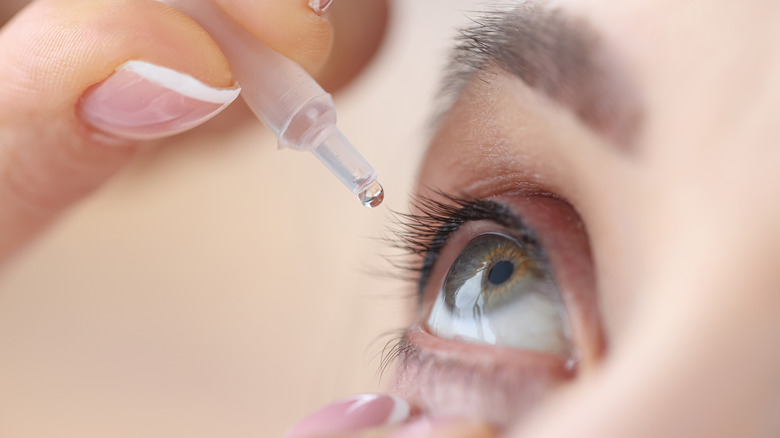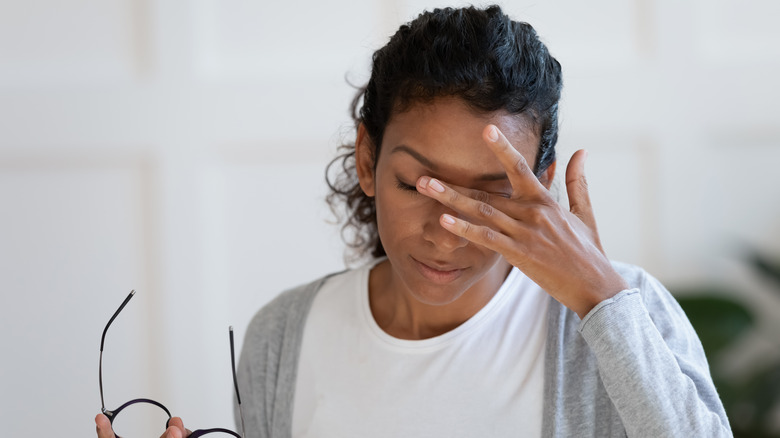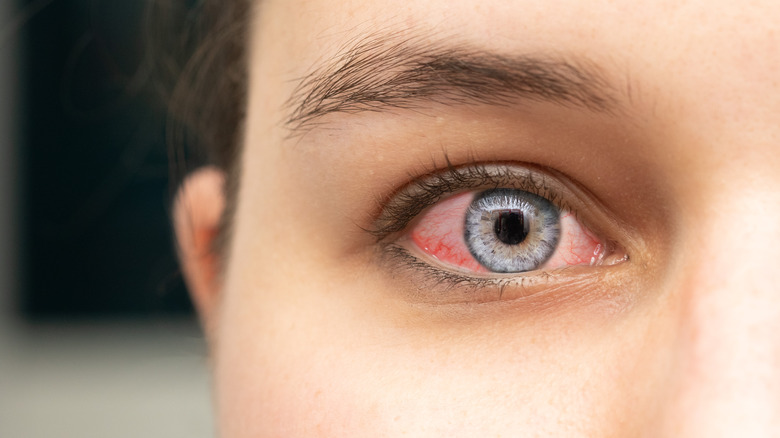Surprising Side Effects Of Using Eye Drops
Few consumers know about the side effects of using eye drops. Most adverse reactions occur after prolonged use, but it's possible to experience stinging, swelling, or itching in or around the eyes from day one. Corticosteroid eye drops, for example, should not be used for longer than two weeks, says the American College of Allergy, Asthma, and Immunology (ACCAI). Decongestant eye drops, on the other hand, should only be used for up to one week.
Eye drops typically contain a saline solution and active ingredients, such as steroids or antihistamines. Artificial tears are often formulated with herbal extracts, hyaluronic acid, or glycerin. Their mechanism of action depends on the ingredients used. Atropine eye drops, for instance, may slow myopia progression (via Current Pharmaceutical Design). Your doctor may prescribe antibiotic eye drops if you have bacterial conjunctivitis or blepharitis.
Some over-the-counter drops may provide temporary relief for eye strain symptoms. These products are not entirely safe, though, and overusing them can further increase the risk of side effects.
Steroid eye drops may cause glaucoma and cataracts
Steroid drops help reduce eye inflammation due to allergies, infections, or other conditions. Unfortunately, they carry serious side effects. Moorfields Eye Hospital warns that corticosteroid eye drops may cause blurred vision and mild stinging. When used in high doses or for prolonged periods, these medications can lead to glaucoma or cataracts.
Prednisolone, one of the most widely used steroid drops, may affect vision or even cause blindness, notes the Mayo Clinic. Other potential side effects include eye discharge, itchiness, redness, swelling, light sensitivity, and ptosis (aka eyelid drooping). The drug can also cause headaches and loss of taste.
But what you should really worry about is the risk of glaucoma and cataracts. These conditions can affect your quality of life and lead to vision loss. Steroid-induced glaucoma is due to an increase in eye pressure, which typically occurs within three to six weeks of topical steroid use, a 2021 report in StatPearls revealed. In severe cases, it may require surgery.
The preservatives in eye drops can trigger allergies
Eye drops can be easily contaminated with bacteria or fungi once you've opened the bottle. Even those containing preservatives have a short shelf life, warns UFS Dispensaries. Generally, they should not be used for more than 28 days after opening. These guidelines vary among brands, though. To stay safe, read the label and follow the manufacturer's instructions.
Preservative-free drops are at higher risk for contamination. Some can only be safely used for up to 24 hours after opening (via American Academy of Ophthalmology). Manufacturers use preservatives to prevent bacterial growth, but these compounds do pose health risks. For one, there's a risk of eyelid swelling, itching, and other allergic reactions. On top of that, benzalkonium chloride and other preservatives in eye drops may cause eczema, hypersensitivity, inflammation, dry eyes, blepharitis, redness, and excessive tearing, a study in the Romanian Journal of Ophthalmology revealed.
The side effects of using eye drops don't stop here. Antibiotic drops, for example, may cause burning, stinging, discomfort, and allergic reactions, notes the U.S. National Library of Medicine. Lubricant eye drops may contain allergens, too.



